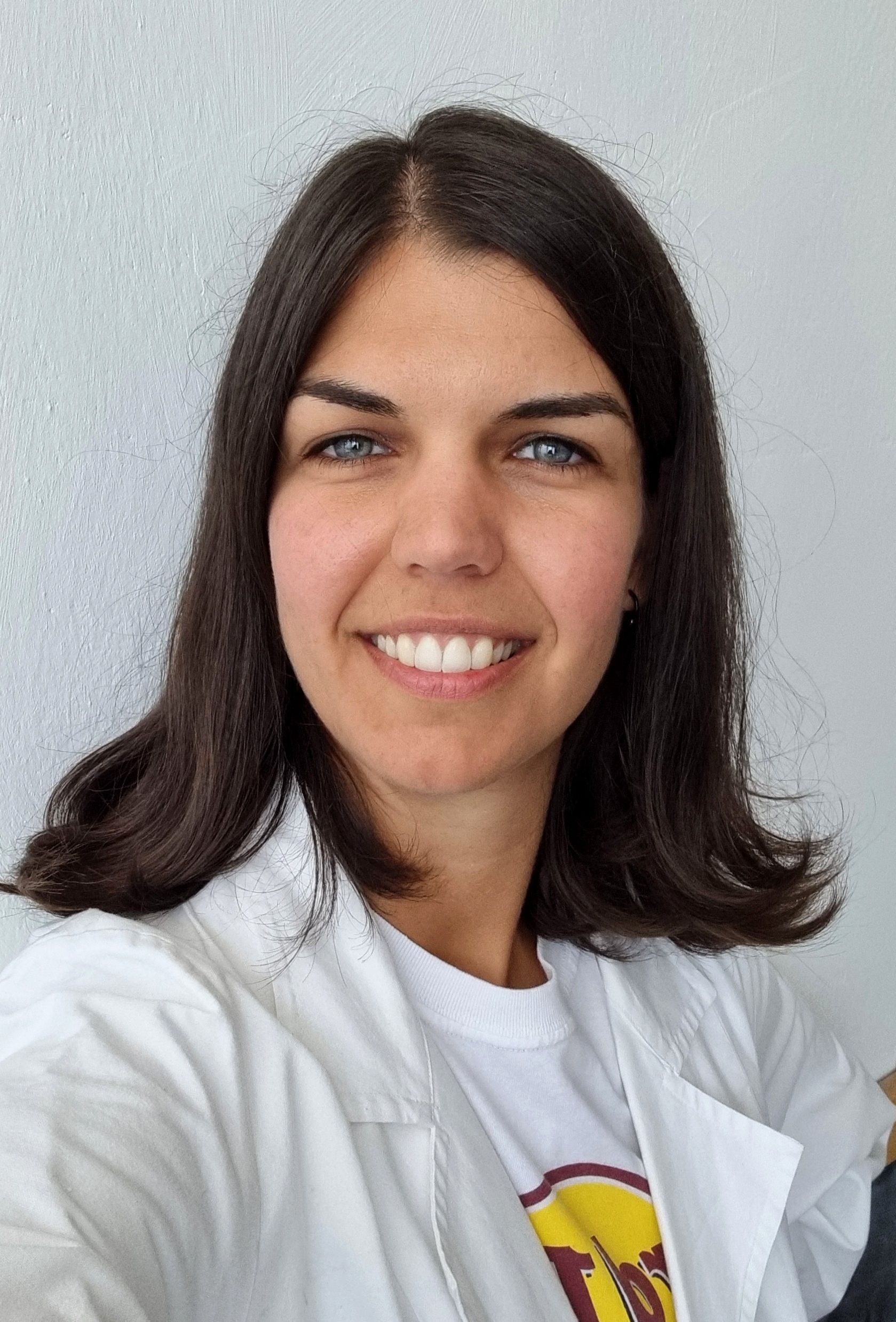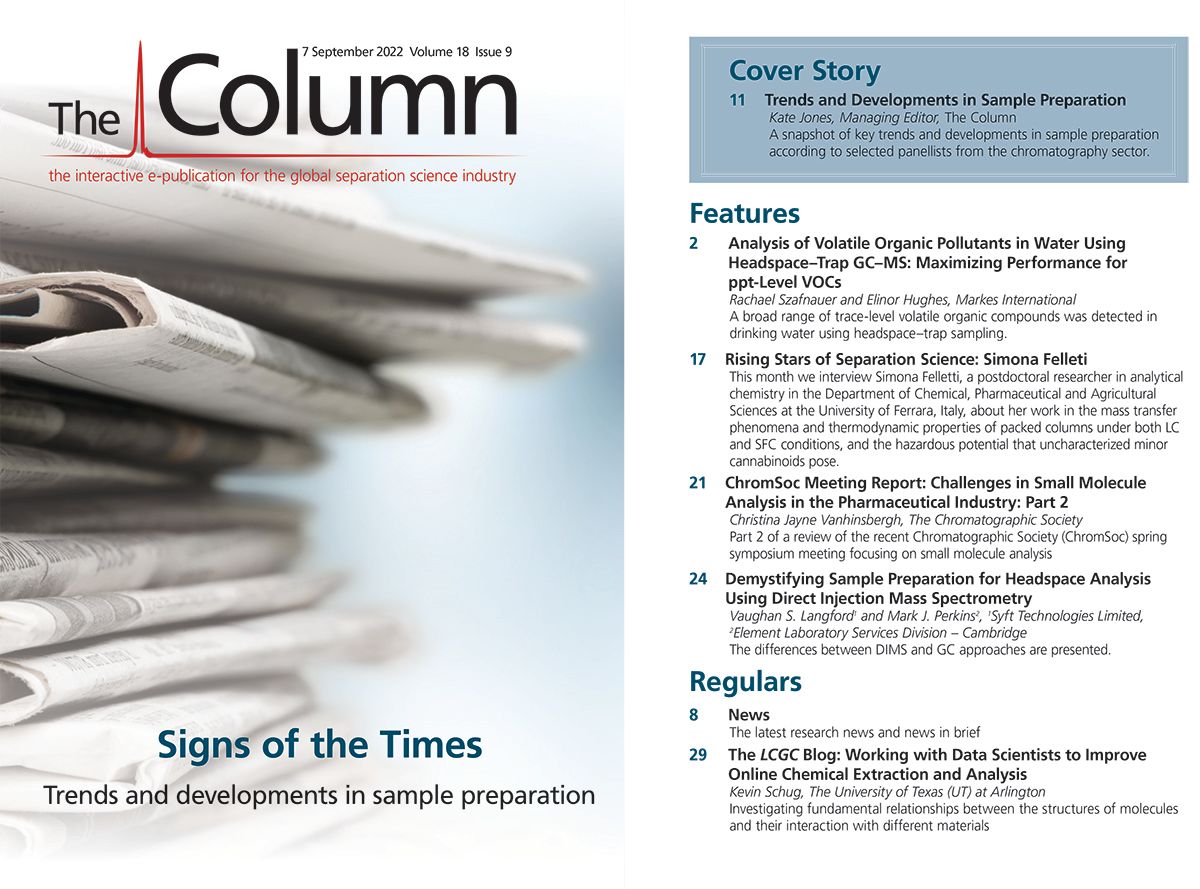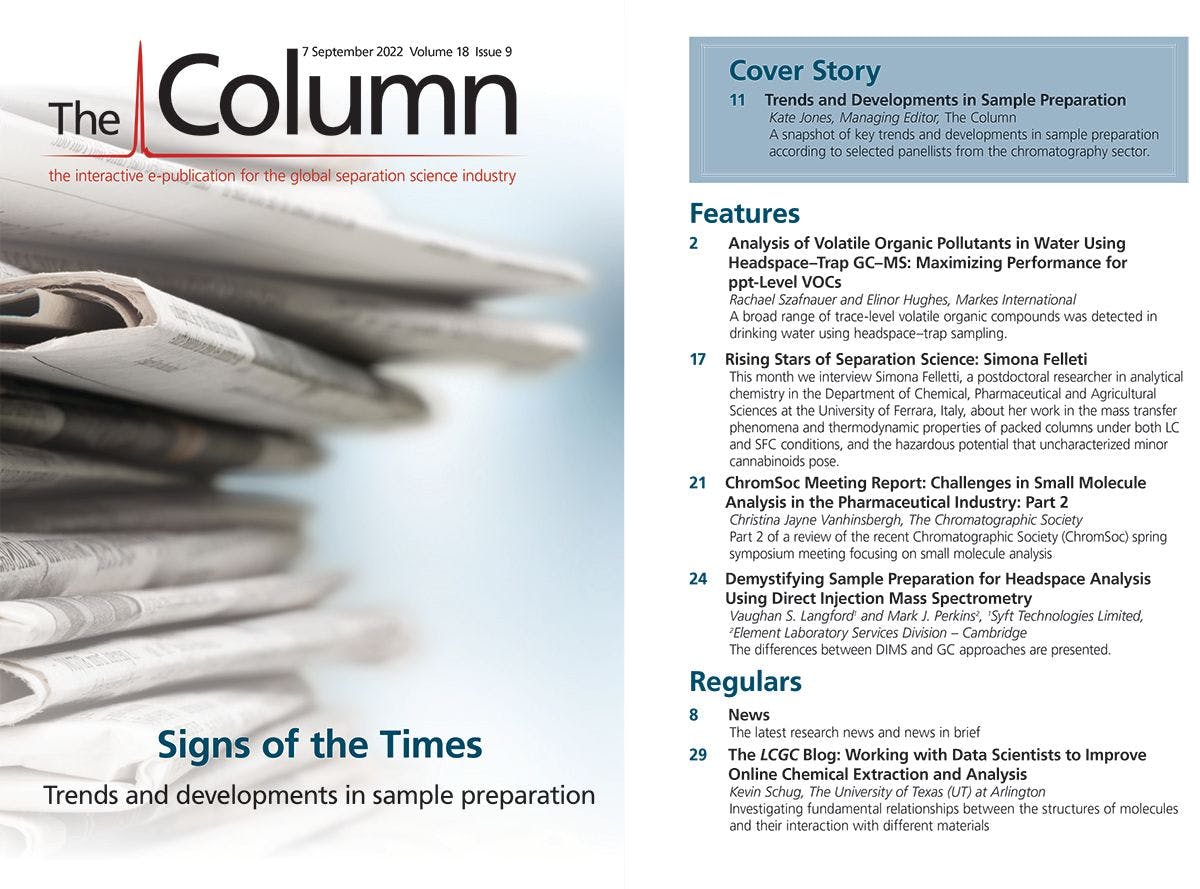Rising Stars of Separation Science: Simona Felletti
This month we interview Simona Felletti, a postdoctoral researcher in analytical chemistry in the Department of Chemical, Pharmaceutical, and Agricultural Sciences at the University of Ferrara, Italy, about her work in the mass transfer phenomena and thermodynamic properties of packed columns under both liquid chromatography (LC) and supercritical fluid chromatographic (SFC) conditions, and the hazardous potential that uncharacterized minor cannabinoids pose.
Q. When did you first encounter chromatography and what attracted you to the subject?
A: It was back in 2013 when I was a bachelor student at the University of Ferrara in Italy. I have always loved TV series based on forensic science, where the culprit is caught thanks to chromatographic analysis. I like the concept of “find what you do not see”, and with chromatography you can find out what is hidden in your sample. At the beginning, what attracted me the most was the application of chromatography to environmental analysis, but I later discovered other interesting aspects of chromatography, such as the theoretical aspects behind adsorption, thanks to my mentor, Alberto Cavazzini.
Q. Can you tell us more about your Ph.D. thesis?
A: My Ph.D. research project focused on the investigation and understanding of rather complex phenomena occurring in packed beds through a combination of experimental and theoretical approaches of linear and nonlinear liquid chromatography (LC). This allows the information needed regarding the kinetics and the thermodynamics of the chromatographic separation process to be obtained. From a theoretical viewpoint, kinetic factors (diffusion, eddy dispersion, mass transfer resistance, finite rate of adsorption/desorption process) directly affect the efficiency of a chromatographic separation, while thermodynamic factors (adsorption equilibria) have an impact on retention and selectivity.
The knowledge of all these contributions is pivotal to developing selective, ultra-fast, and highly efficient separation methods, and for the design of novel stationary phases.
Q. What chromatographic techniques have you worked with?
A: I currently work with different scales of chromatography, going from analytical to preparative applications. For analytical, highly efficient, and fast separations, I work with supercritical fluid chromatography (SFC) and ultrahigh-performance liquid chromatography (UHPLC). In preparative-scale chromatography, I work with traditional single-column batch LC and also with multi-column, continuous techniques for the purification, isolation, and enrichment of compounds, such as multi‑column countercurrent solvent gradient purification (MCSGP), simulated moving bed (SMB), and N-Rich techniques. In other words, my working range goes from sub-2-µm to 20‑µm porous particles, or from 0.1 to 10 mL/min.
Q. Your primary research focus is on the study of mass transfer phenomena and thermodynamic properties of packed columns under both LC and SFC conditions—what specifically attracted you to this area of research?
A: I am a curious person and I like discovering and knowing the reasons behind something. This also happens with my research, where fundamental studies contribute to the (almost) complete understanding of the theoretical reasons at the basis of the separation process.
Indeed, the knowledge of mass transfer and adsorption phenomena is important, not only for the comprehension of retention and molecular recognition mechanisms but also for practical reasons, because it is the basis of the modelling of separation under different experimental conditions—including overloading and gradient. The possibility of predicting both the retention and peak shape of a target compound and how they can be modulated by modifying the experimental conditions (mobile phase composition, flow rate) allows the chromatographic method to be optimized to maximize speed, resolution, and selectivity.
For example, regarding chiral chromatography, these studies contribute to shedding light on some fundamental questions, such as the relationship between chiral discrimination (enantioselectivity) and adsorption-desorption kinetics, and its dependence on some experimental parameters, including the loading of chiral selector, the particle geometry, and the pore size.
Much work has been done in this field (1,2), but there is much more to be discovered, and we are trying to make our contribution.
Q. You have recently published a paper investigating the effect of the polarity of the stationary and mobile phases on the retention of cannabinoids in normal-phase LC (3). What advantages does it offer over reversed-phase LC?
A: Reversed-phase LC is currently the preferred and most employed chromatographic mode for the separation of cannabinoids. However, particularly for preparative purposes where large amounts of compounds are processed, water‑based eluents show some limitations, namely scarce solubility of cannabinoids, large back pressure, and energy-consuming solvent removal. In this field, normal-phase LC could offer several advantages over reversed-phase LC. Indeed, the use of apolar solvents facilitates sample preparation (leger solubility of hemp extracts), makes solvent evaporation from purified fractions easier, and allows for faster runs (the lower back pressure permits the use of higher flow rates). Moreover, thanks to the different retention mechanism (adsorption vs. partition), different selectivities may be obtained with respect to reversed-phase LC.
However, conversely to reversed-phase LC, no fundamental studies about the employment of normal-phase elution mode for the separation of cannabinoids were available in the literature. In this work, we investigated from a fundamental viewpoint the effect of polarity and the type of interaction mechanisms of four different adsorbents on the retention of selected cannabinoids using a variety of mobile phase compositions under normal phase conditions.
The results of this work may be useful for the setting up of purification procedures, or in cases where orthogonal methods to reversed-phase LC are needed, to help in the selection of the proper stationary phase and experimental conditions for cannabinoids analysis and isolation.
Q. Are there any challenges involved with using this method?
A: A critical point when using normal phase for the separation of cannabinoids is the resolution of the early eluting compounds. However, peaks can be resolved (or partially resolved) by modulating either the percentage or the type of the polar modifier in the mobile phase.
Another thing to keep in mind is the dissolution of apolar compounds, such as waxes, that occurs when sample extraction is performed with heptane or hexane. The removal of these compounds is pivotal, especially in preparative scale where large amounts of sample are processed, in order not to damage the chromatographic column.
Last but not least, the use of proper instruments compatible with apolar solvents is required.
Q. No fundamental studies about the employment of normal-phase LC or chiral chromatography for the separation of cannabinoids have been performed. Is this something you plan to explore further in the future?
A: Despite the fact that the plant Cannabis Sativa L. has been known for millennia, the analysis of cannabis products and extracts is a relatively new topic, having only taken place in recent years after the legalization and depenalization of cannabis in many states. As a consequence, scientists have focused their attention on the development of experimental procedures for the extraction and the analytical separation of cannabinoids. Nevertheless, since new cannabinoids are continuously discovered and isolated, new analytical methods with different and enhanced selectivity with respect to the traditional C18 columns are required. Therefore, our research is focused on the development of alternative analytical methods for cannabinoids separation, and we have started with some theoretical studies devoted to the understanding of the interaction mechanisms between cannabinoids and different stationary phases in normal-phase LC and chiral reversed‑phase LC. We are planning to perform complete kinetic and thermodynamic studies on different stationary phases (both achiral and chiral), including SFC elution mode.
Q. There is concern about the hazardous potential of uncharacterized minor cannabinoids, including chiral ones. The development of LC methods for the enantioseparation of cannabinoids is therefore very topical. Another of your recent papers discusses the retention behaviour of natural cannabinoids on differently substituted polysaccharide‑based chiral stationary phases under reversed-phase LC conditions (4). Please could you discuss your results and how it could help in the future characterization of cannabis samples.
A: Up to date, there is still no analytical method that permits the complete characterization of cannabis samples in terms of purity, amount, and enantiomeric excess.
Theoretically, in chiral analysis, the number of cannabinoids to be resolved is (almost) double with respect to achiral analysis, since both (+) and (–) enantiomers could be present. This makes the development of effective separation methods even more challenging. In this context, our work is intended to start the investigation of the most suitable chiral stationary phase (CSP) for the chiral characterization of hemp samples. In this work, a screening of stationary and mobile phases was performed to understand the effect of substituents (either electron‑donating or electron-withdrawing) present in the polysaccharide-based CSPs on the retention and selectivity of cannabinoids.
The choice of the correct stationary phase chemistry may help in the comprehensive characterization of the sample, which is useful in regulatory environments for the detection of impurities, and in forensic toxicology. It also assists in the development of preparative methods for the isolation of single enantiomers. These methods will permit investigatation of their biological activity to produce analytical‑grade standards.
For example, if the quantification of cannabichromene (CBC), sold as a racemic mixture, is performed with an achiral method, results may be misleading (being the sum of both +and – enantiomers). The same happens with other cannabinoids, like tetrahydrocannabinol (Δ9-THC), whose (+)-enantiomer has been found with an enantiomeric excess of 0.27% in medicinal marijuana.
Q. What projects are you currently working on?
A: On the analytical side, we are currently exploring retention behaviour and performing kinetic studies of several biopharmaceuticals and other molecules of industrial interest on different column chemistries (traditional C18, doped phases, polar phases, polysaccharide‑based, Pirkle‑type), particle types (totally porous, superficially porous), and elution modes (normal‑phase LC, reversed‑phase LC, SFC). We are also focused on the replacement of toxic solvents commonly used in LC, such as acetonitrile, with greener and harmless ones (for example, dimethyl carbonate and dimethyl isosorbide). The aim is to understand whether green solvents can be used as an alternative to traditional ones to perform cost-effective, efficient separations of the molecules under investigation.
On the preparative side, by using data collected in the analytical scale, and also through the use of simulation and modelling codes, we are developing purification methods for both peptides and cannabinoids, using single-column and multi-column techniques (MCSGP and SMB), in collaboration with several companies. We are also comparing the purification performance of traditional and green solvents.
Completing all these studies is an ambitious goal, but the obtained data will help chromatographers in the selection of the proper combination of stationary and mobile phases depending on their purpose.
Q. You recently came first in the HTC Tube Contest at the HTC-17 conference in Ghent, Belgium. How was it presenting your research in a three-minute video?
A: I like new challenges and I try to push myself beyond my comfort zone because I am a very creative person. It was really stimulating to present my research in an unconventional way through a short and funny video. At the HTC conference, I was very excited and I can say that the audience appreciated my video and had a good time. As I really enjoyed this experience, I decided to create another video and to participate to the HPLC Tube Contest in San Diego (California, USA) (HPLC 2022). I also managed to thrill the audience on this occasion, winning the first prize!
Q. Anything else you would like to add?
A: I would like to thank my mentor, Alberto Cavazzini, for giving me the opportunity to join his group at the University of Ferrara. During these six years, I have had the chance to spend different periods in qualified research centres and to meet esteemed researchers all around the world. I also want to thank my research group and all the people involved in our projects for the support and for believing in me. I would never be where I am today without them.
References
- S. Felleti, C. De Luca, G. Lievore, et al., J. Chromatogr. A1630, 461532 (2020).
- O.H. Ismail, M. Antonelli, A. Ciogli, et al., J. Chromatogr. A 1520, 91–102 (2017).
- C. De Luca, A. Buratti, Y. Krauke, et al., Analytical and Bioanalytical Chemistry 414, 5385–5395 (2022).
- C. De Luca, A. Buratti, W. Umstead, et al., J. Chromatogr. A1672, 463076 (2022).

Simona Felletti is a postdoctoral researcher in analytical chemistry in the Department of Chemical, Pharmaceutical, and Agricultural Sciences at the University of Ferrara, Italy, in the group of Alberto Cavazzini. Her research focuses on the study of mass transfer phenomena and the thermodynamic properties of packed columns under both liquid and supercritical fluid chromatographic conditions (LC, SFC), as well as the development of methods for the purification of bioactive molecules, such as peptides and cannabinoids using both single-column and multi-column continuous techniques. She is author or co-author of 25 articles in peer-reviewed journals, and she has presented her work in more than 20 national and international meetings. In 2021, she was the recipient of the Ervin Kováts Award for Young Scientists from the Hungarian Society for Separation Sciences. She achieved second place at the Separation Science Slam Competition at the HPLC 2019 symposium (Milan, Italy) and, more recently, first place at both the HTC Tube Contest at the HTC-17 symposium (Ghent, Belgium, in 2022) and at the HPLC Tube Contest at the HPLC 2022 symposium (San Diego, California, USA).

Common Challenges in Nitrosamine Analysis: An LCGC International Peer Exchange
April 15th 2025A recent roundtable discussion featuring Aloka Srinivasan of Raaha, Mayank Bhanti of the United States Pharmacopeia (USP), and Amber Burch of Purisys discussed the challenges surrounding nitrosamine analysis in pharmaceuticals.
Silvia Radenkovic on Building Connections in the Scientific Community
April 11th 2025In the second part of our conversation with Silvia Radenkovic, she shares insights into her involvement in scientific organizations and offers advice for young scientists looking to engage more in scientific organizations.
Regulatory Deadlines and Supply Chain Challenges Take Center Stage in Nitrosamine Discussion
April 10th 2025During an LCGC International peer exchange, Aloka Srinivasan, Mayank Bhanti, and Amber Burch discussed the regulatory deadlines and supply chain challenges that come with nitrosamine analysis.















